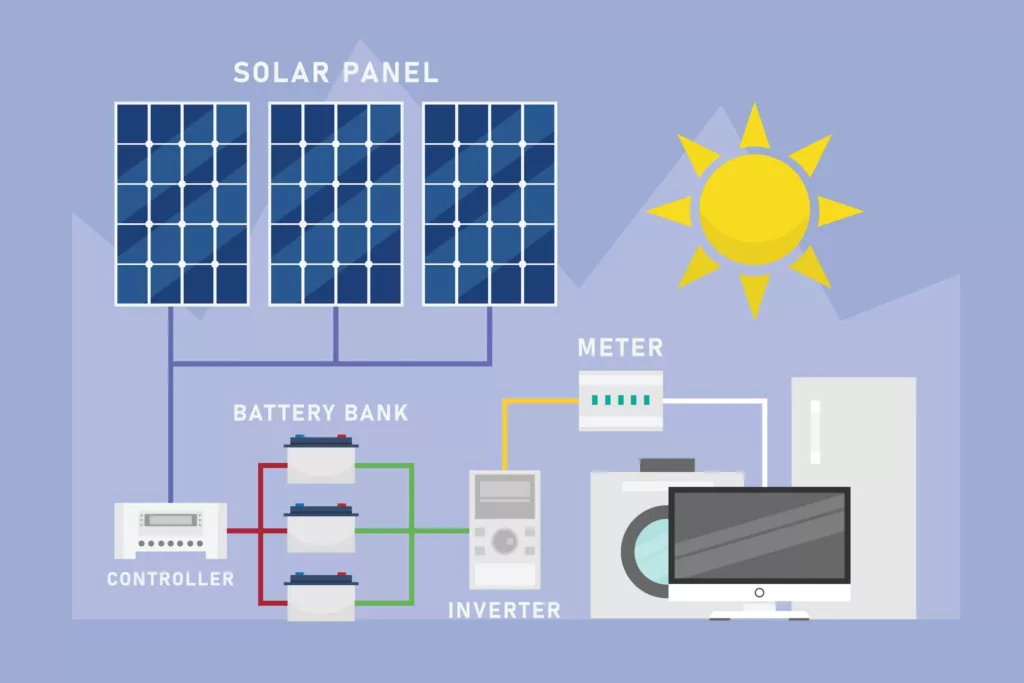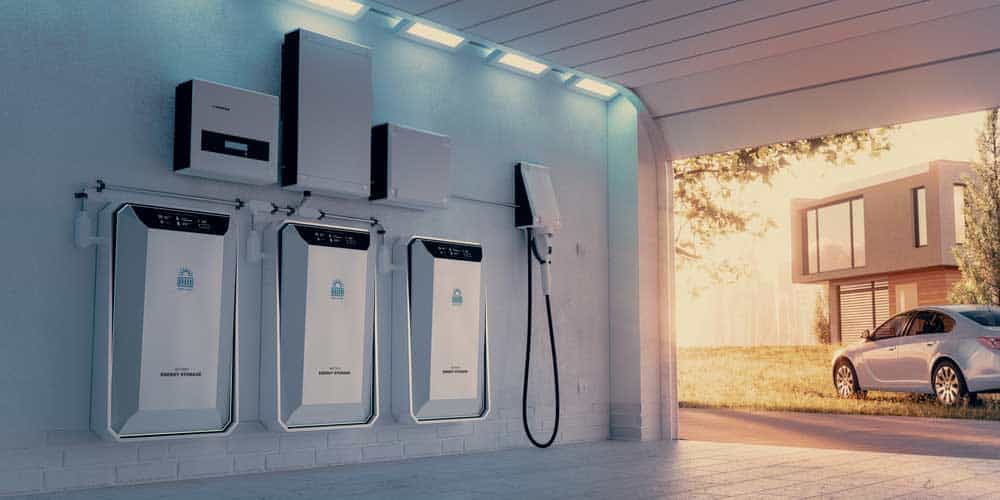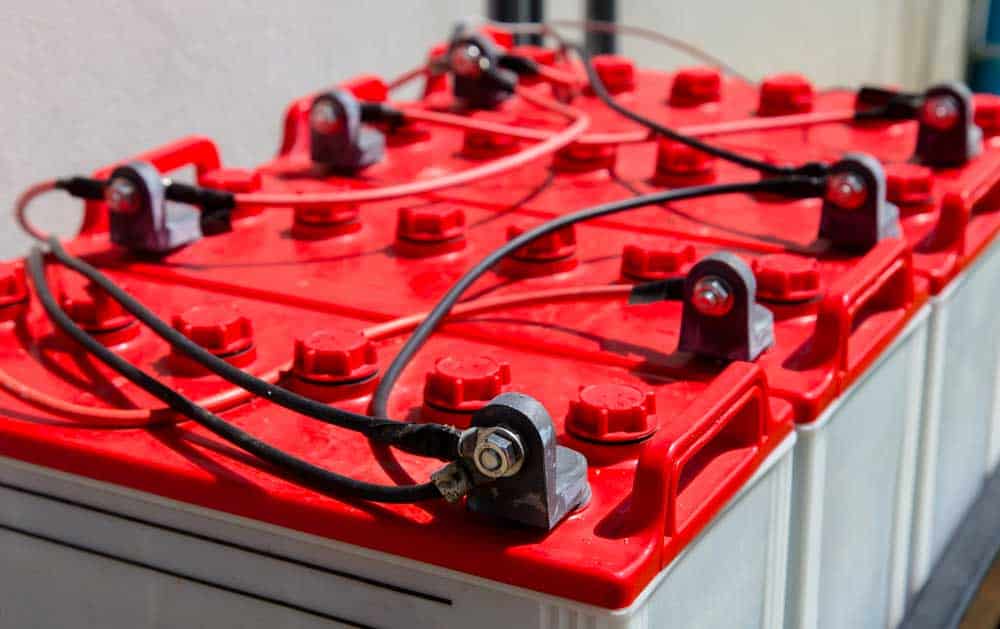Solar batteries are an essential part of your home energy system. Adding Battery to Existing Solar Power System will allow you to store excess solar energy and use it later in the day or night when there is less sun. This will also lower the cost of your electricity bills and ultimately make your home more efficient. The bottom line is finding the right batteries for your situation. In this article, we’ll give you tips on choosing and integrating batteries into your home grid.
How to add batteries to existing solar systems?

Concept of energy storage system
Here are the different ways you can add batteries to solar systems.
DC Coupling
Installing a DC-coupled system involves a complete overhaul of your inverter system. You will need a hybrid inverter compatible with your solar panels and batteries. Just like typical chargers, solar power that your PhotoVoltaic panel (Direct Current) harnesses charges your batteries. The DC electricity is then sent through the hybrid inverter, which changes it to AC electricity. Finally, you can use the AC electricity in your home or business or let it flow back onto the utility grid.
Pros
- Adding a battery to a solar system using DC Coupling increases the efficiency of your power system. You lose little power in converting from DC power to electricity compatible with your household.
- A higher number of off-grid inverters are compatible with the DC Coupling method.
- DC Coupling also works with a greater variety of battery sizes.
Drawbacks
- The initial cost of getting a new hybrid inverter is high. With wiring and labor costs, DC coupling may be out of the pocket range of most people.
AC Coupling
If the first method doesn’t suit you, you may opt for AC Coupling if you want to add a battery to the existing solar system. This involves getting a second inverter on top of the one your solar power system already has. While the first inverter typically converts DC power from the PV panels into AC electricity, you can use this electricity directly in the household or pump it into your batteries. This is where your second inverter comes in to charge the batteries. Once your power storage batteries are fully charged, your inverter sends excess AC power to the national grid.
Pros
- The installation process is relatively simple as it does not involve overhauling the wiring or solar power system.
- It is cheaper than DC coupling because you can use different types of inverters.
Cons
- It is inefficient because you lose some power during the conversion process.
- It can only work with specific sizes of batteries; thus, scaling up your batteries may be a challenge.
Installing a Storage-Ready Inverter

Solar Panel cell System with Hybrid Inverter
This option involves getting a new inverter compatible with a power storage system. While the initial cost is high, as you have to replace your inverter, this approach is simple and works with all solar power systems.
These inverters simplify the process of adding batteries to solar systems as they come conditioned for battery power storage. Also, it automatically sends power to the national grid when your PV panels generate power at peak times.
Pros
- Simple installation guidelines. While you’ll still need a technician, exchanging the inverter is straightforward.
- Compatible with all grid-tied solar power systems
- New inverters come with additional features that simplify power generation. This can help you in your net metering arrangement with the power provider.
- You require little labor.
Adding Battery to Existing Solar Power System: Cons
- The initial capital outlay is relatively high. Replacing your inverter may set you back up to ten grand.
Factors that determine solar batteries cost

Concept of a home battery energy storage
After settling on a planned method to add batteries to the existing solar system, you may wonder how much a new set of solar batteries will cost. The answer depends on multiple factors. Let’s go over the costs associated with solar battery installation and what you can do to reduce the price tag.
Incentives and Rebates
In 2022, congress renewed the Federal Investment Tax Credit, which provides a 30% tax incentive for solar systems. This program runs up to 2032 and will help you relatively cheaply to add batteries to the existing solar system.
State governments have also chipped in to help cut the costs associated with solar batteries. California offers rebates of up to $1,000 per kWh of storage. Maryland has also encouraged its residents and business owners to go green. The state awards 30% of the total cost of installation to commercial and residential property owners to add batteries to the existing power systems.
Adding Battery to Existing Solar Power System: Installation costs in your area
The cost of installation depends on various factors, such as:
- Special equipment that needs you to purchase, such as a backup load panel
- The size of your solar array and battery bank
- Whether or not you need a backup load panel
- Brand of batteries chosen
- The number of batteries
Adding Battery to Existing Solar Power System: Number of Batteries Installed
The more batteries you install, the more expensive it will be for you. This cost fluctuates based on the battery storage capacity and how long you want the batteries to store power. If you have a large solar system or need to store backup power for longer, your system requires more batteries, making it relatively costly.
Adding Battery to Existing Solar Power System: Battery Chemistry
Most solar power users lean towards Lithium-ion batteries for their homes. While they’re more expensive, Lithium-ion batteries last longer and are more efficient than lead acid. They also have a longer lifespan, giving you more service than the alternative. Lithium-ion batteries are also safer for the environment because they don’t contain toxic chemicals like lead in lead-acid batteries.

Lead-acid batteries
Lead Acid Batteries are cheaper than lithium-ion ones but need replacement more frequently. Moreover, they are less efficient and have a smaller capacity for power storage. Lead acid batteries also need regular maintenance, which involves the tedious process of adding battery water.
Adding Battery to Existing Solar Power System: Battery Brand
The brand of solar battery you choose will affect the cost, performance, and warranty. Some less expensive batteries have a short warranty which is not desirable when dealing with equipment that requires such heavy capital outlay.
Other incentives from battery manufacturers, such as after-sales service, also contribute to the initial cost of a solar power battery.
FAQs
Are solar batteries worth the cost?
Adding batteries to a solar system is a decision you will not regret. Solar batteries can store excess power the solar panels generate during daylight. This can be especially useful in areas where sunlight is limited during winter. You can use them as backup power if there is a power outage.
You can also use solar power to take advantage of net metering. This means that the inverter will store energy in your batteries when it’s cheaper and use that energy when it’s more expensive. This will go a long way in cutting down your energy bills.
How much battery storage is needed for solar?
Your battery storage needs are directly proportional to your power consumption and whether you use it for backup or run the entire house. A typical home needs just 30Kwh of electricity daily. So, your battery capacity should match this.
Where should I install my solar battery?
You should install your batteries out of children’s reach. The setup would be perfect in the basement or garage. Consult your technician for advice, as the installation is permanent and cannot change.
Summary
Solar batteries are a great way to combine solar power generation and storage in one convenient package. They enable you to use solar power for more things. It’s ultimately up to you to decide what works best for your needs and budget. The same applies if you add a battery to an existing solar system. It all depends on your budget and needs as a home or business owner who uses solar power.
